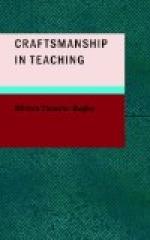II
And so the first step to take in getting more efficient work from young teachers, and especially from inexperienced and untrained teachers fresh from the high school or the college, is to make sure that they know what is expected of them. Now this looks to be a very simple precaution that no one would be unwise enough to omit. As a matter of fact, a great many superintendents and principals are not explicit and definite about the results that they desire. Very frequently all that is asked of a teacher is that he or she keep things running smoothly, keep pupils and parents good-natured. Let me assert again that this ought to be done, but that it is no measure of a teacher’s efficiency, simply because it can be done and often is done by means that defeat the purpose of the school. As a young principal in a city system, I learned some vital lessons in supervision from a very skillful teacher. She would come to me week after week with this statement: “Tell me what you want done, and I will do it.” It took me some time to realize that that was just what I was being paid to do,—telling teachers what should be accomplished and then seeing that they accomplished the task that was set. When I finally awoke to my duties, I found myself utterly at a loss to make prescriptions. I then learned that there was a certain document known as the course of study, which mapped out the general line of work and indicated the minimal requirements. I had seen this course of study, but its function had never impressed itself upon me. I had thought that it was one of those documents that officials publish as a matter of form but which no one is ever expected to read. But I soon discovered that a principal had something to do besides passing from room to room, looking wisely at the work going on, and patting little boys and girls on the head.
Now a definite course of study is very hard to construct,—a course that will tell explicitly what the pupils of each grade should acquire each term or half-term in the way of habits, knowledge, ideals, attitudes, and prejudices. But such a course of study is the first requisite to efficiency in teaching. The system that goes by hit or miss, letting each teacher work out his own salvation in any way that he may see fit, is just an aggregation of such schools as that which I have described.
It is true that reformers have very strenuously criticized the policy of restricting teachers to a definite course of study. They have maintained that it curtails individual initiative and crushes enthusiasm. It does this in a certain measure. Every prescription is in a sense a restriction. The fact that the steamship captain must head his ship for Liverpool instead of wherever he may choose to go is a restriction, and the captain’s individuality is doubtless crushed and his initiative limited. But this result seems to be inevitable and he generally manages




